How to Promote Healthier and More Sustainable Food Choices: The Case of Portugal
Abstract
1. Motivation
2. Data and Methods
2.1. Respondents and Sample Procedure
2.2. Variables and Model Specification
3. Results
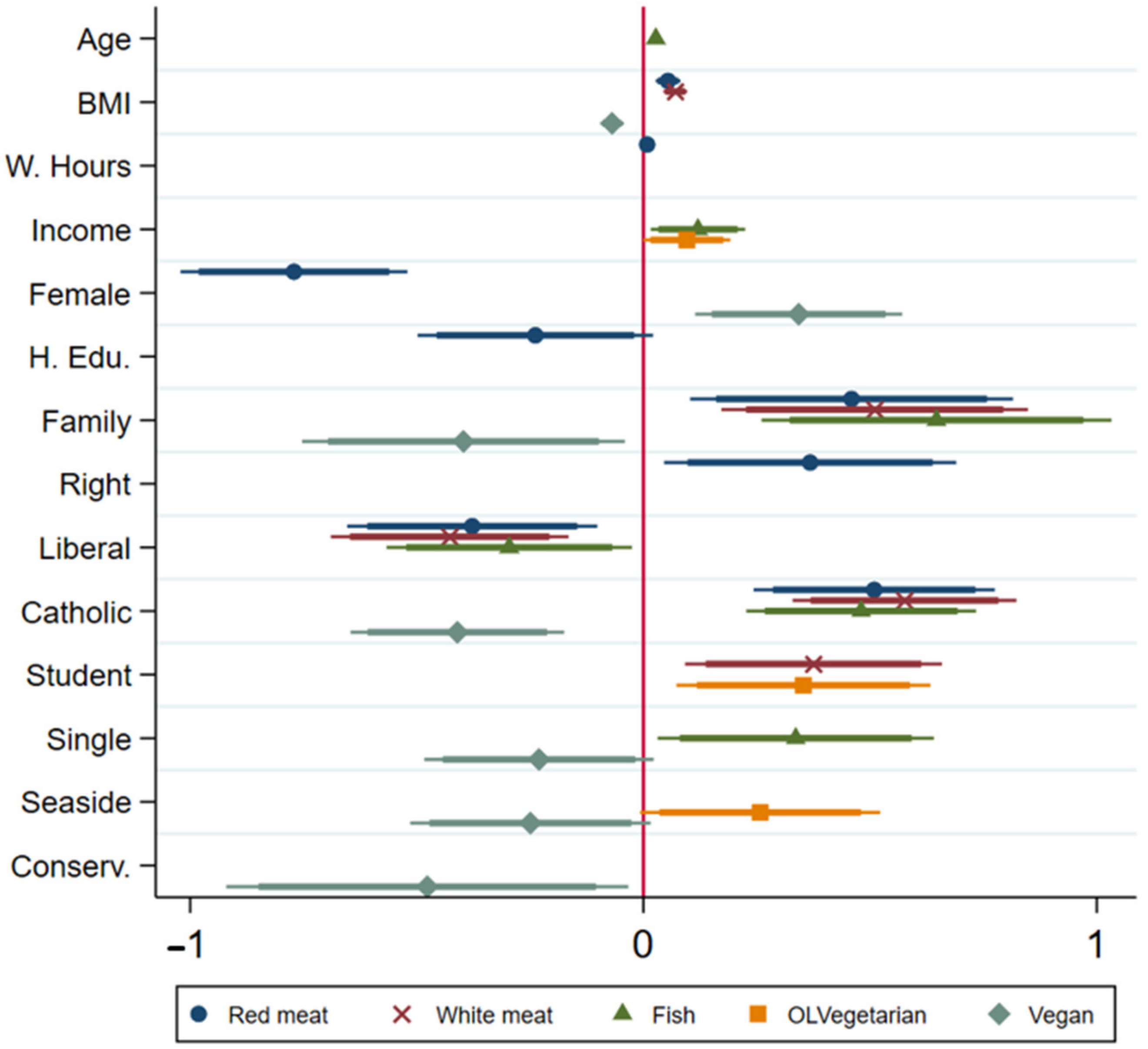
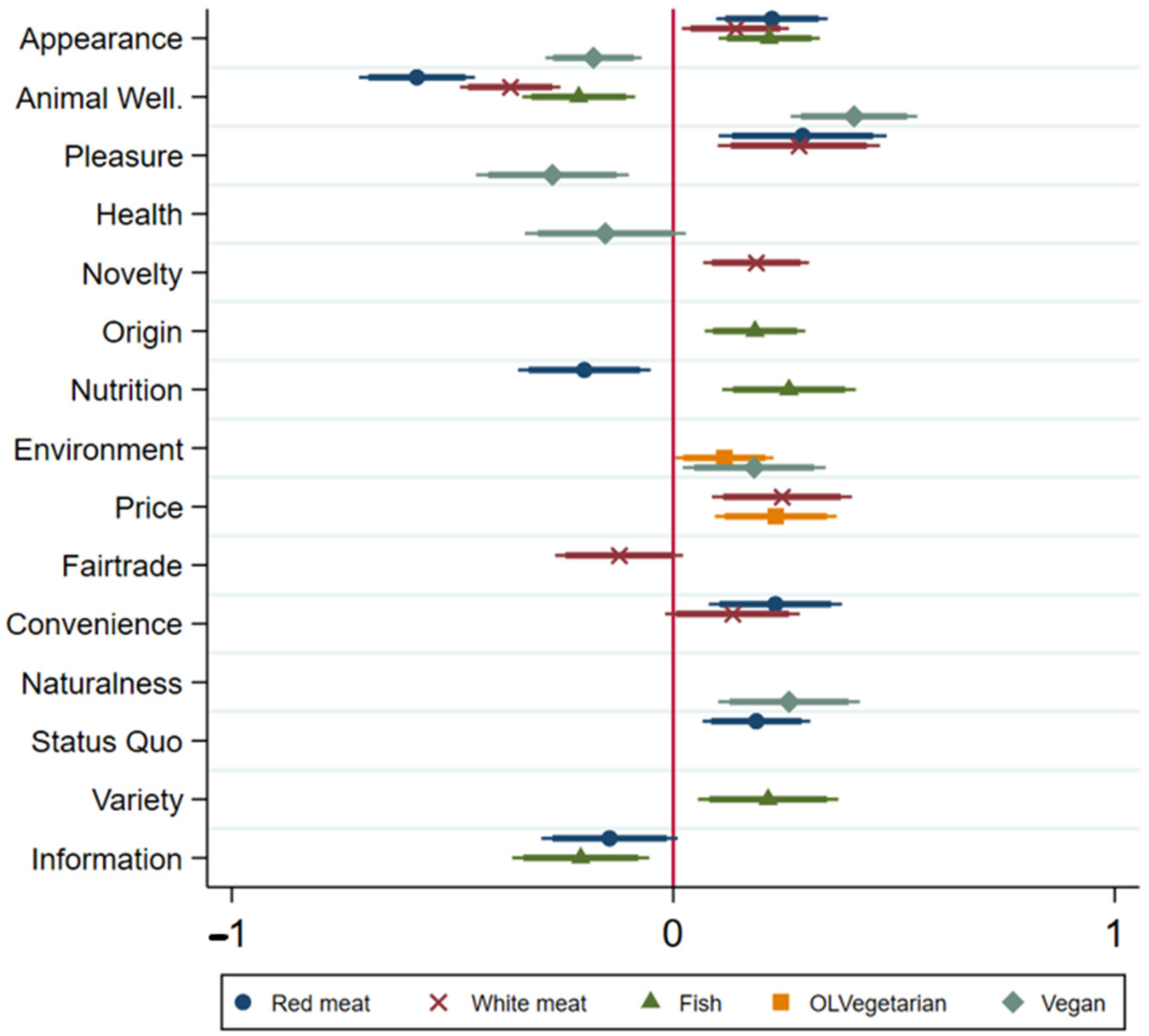
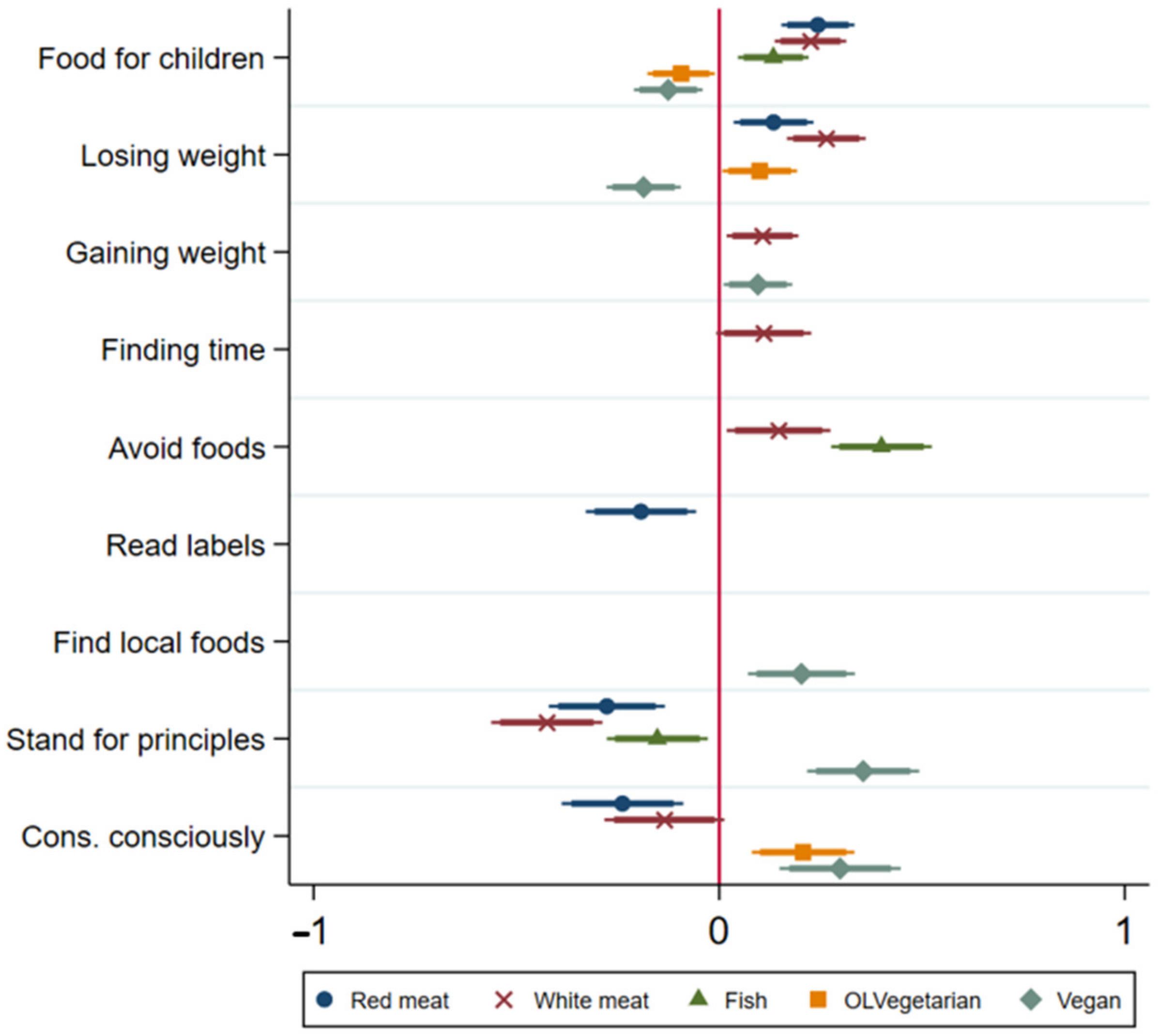
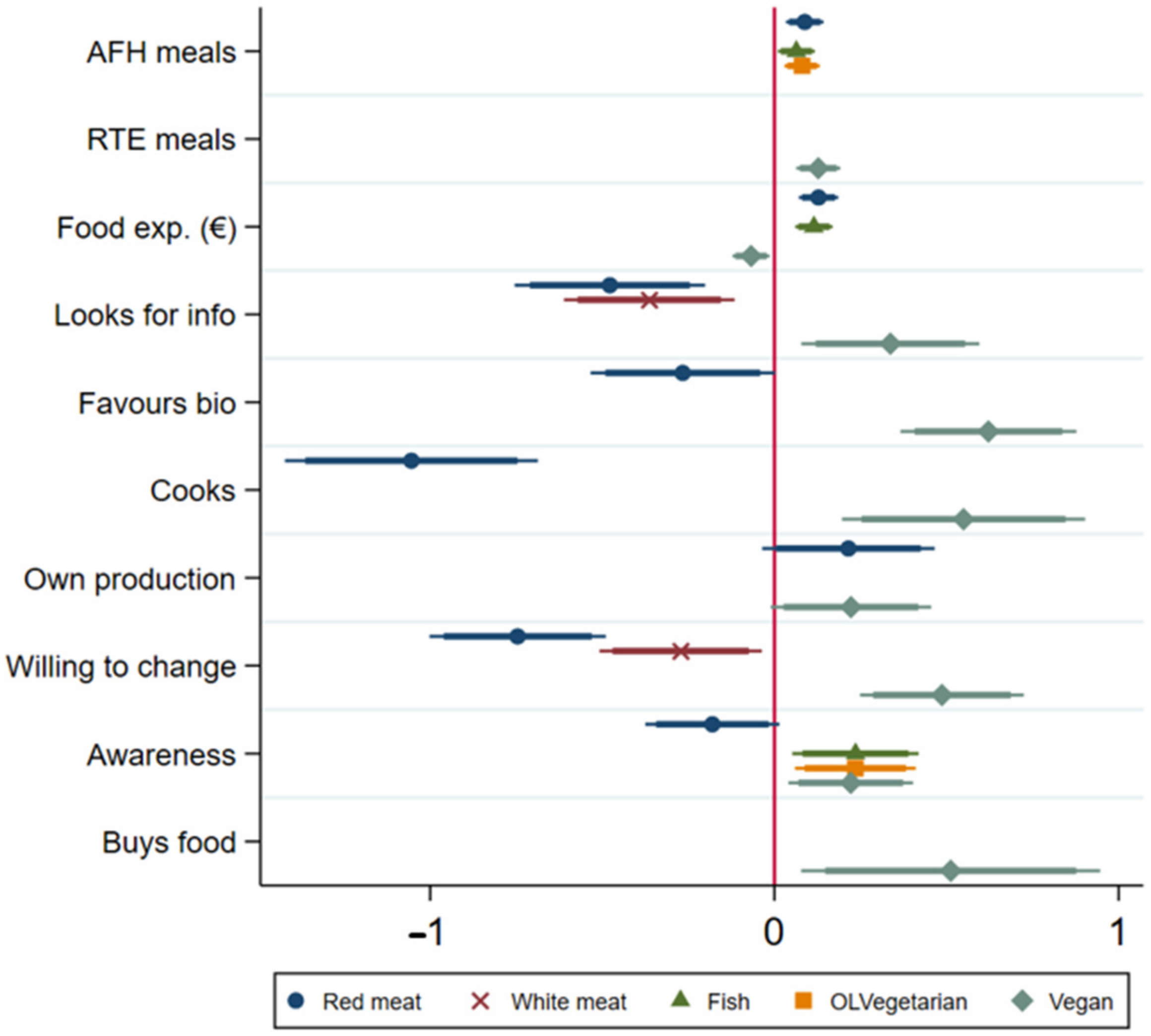

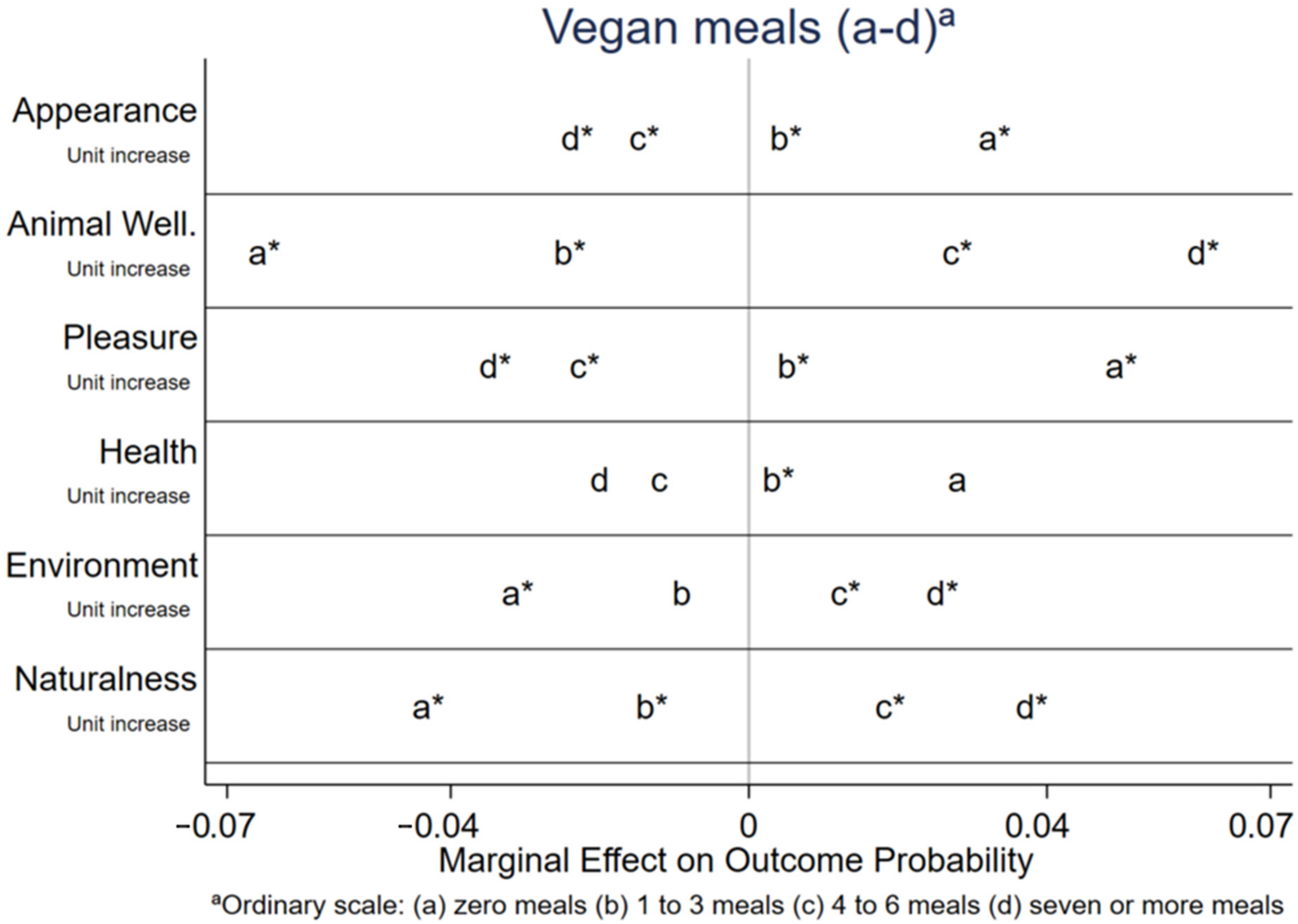
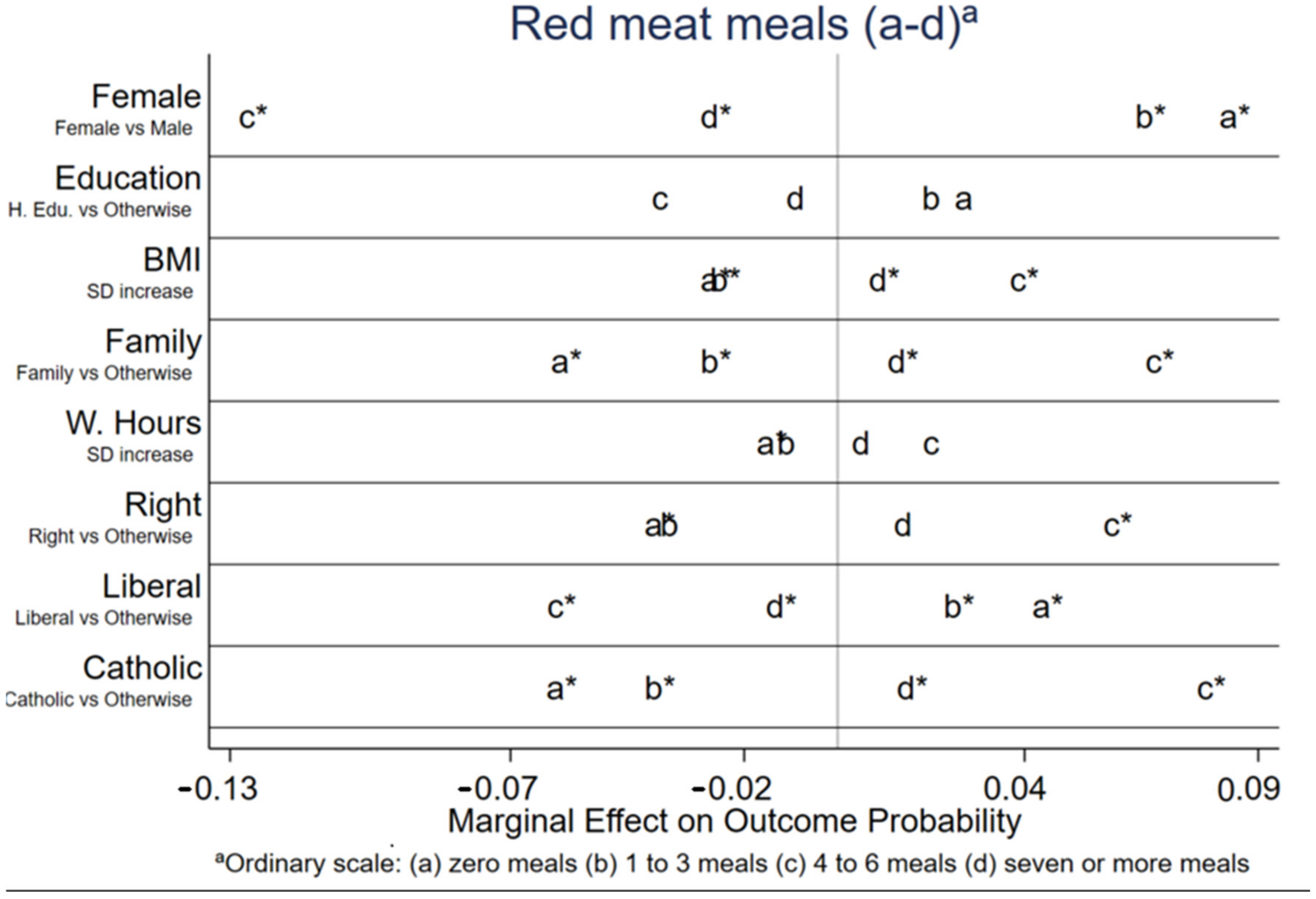
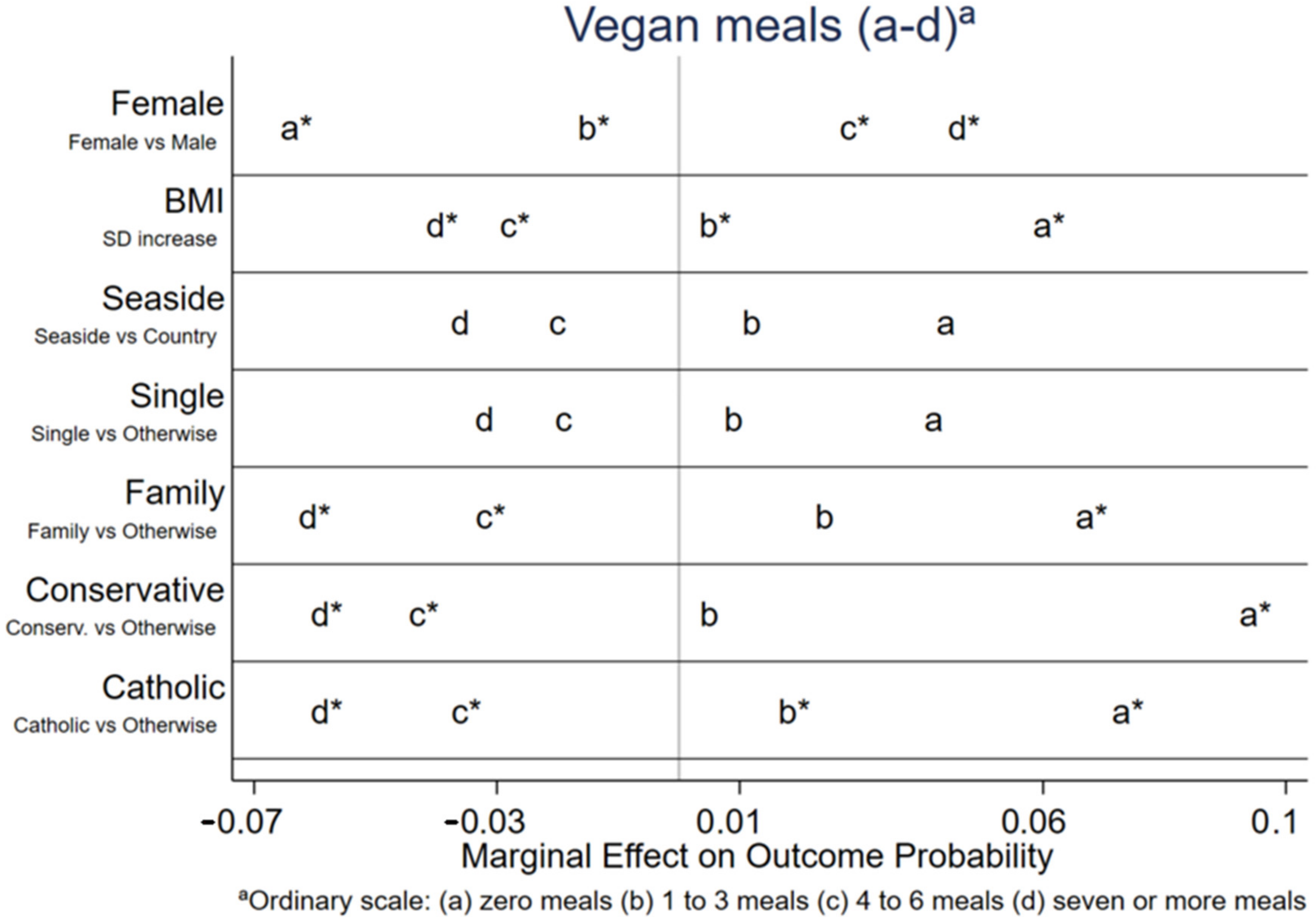
4. Discussion
Food Policy Implications on Promoting Healthy and More Sustainable Food Choices
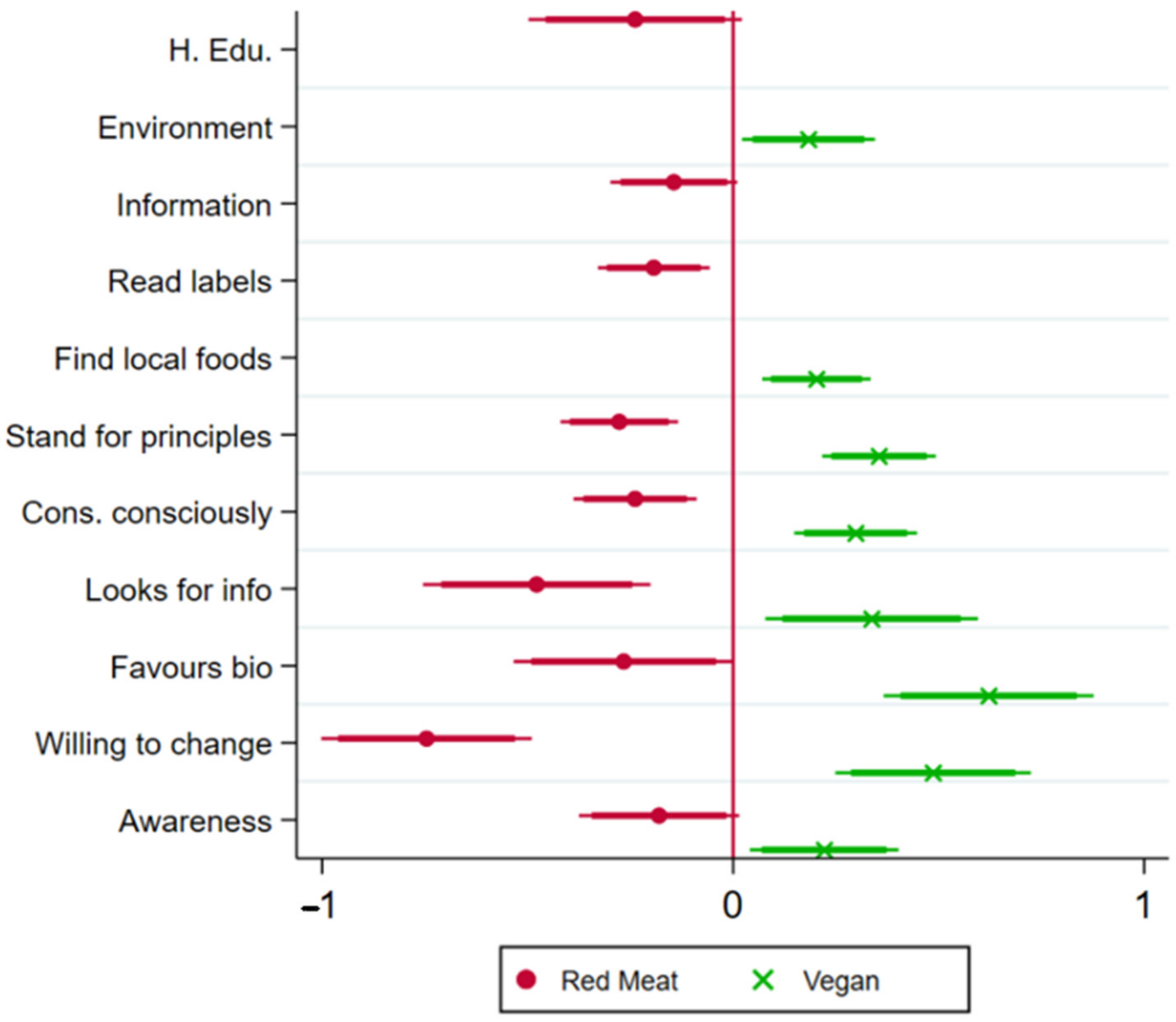
5. Conclusions
Supplementary Materials
Author Contributions
Funding
Institutional Review Board Statement
Informed Consent Statement
Data Availability Statement
Acknowledgments
Conflicts of Interest
References
- Gordon, L.J.; Bignet, V.; Crona, B.; Henriksson, P.J.G.; Van Holt, T.; Jonell, M.; Lindahl, T.; Troell, M.; Barthel, S.; Deutsch, L.; et al. Rewiring Food Systems to Enhance Human Health and Biosphere Stewardship. Environ. Res. Lett. 2017, 12, 100201. [Google Scholar] [CrossRef]
- Popkin, B.M. Nutritional Patterns and Transitions. Popul. Dev. Rev. 1993, 19, 138–157. [Google Scholar] [CrossRef]
- Popkin, B.M. Technology, Transport, Globalization and the Nutrition Transition Food Policy. Food Policy 2006, 31, 554–569. [Google Scholar] [CrossRef]
- Bennett, M.K. Wheat in National Diets. Wheat Stud. Food Res. Inst. 1941, 18, 37–76. [Google Scholar]
- FAO. FAOSTAT Online Database. Available online: http://faostat.fao.org (accessed on 6 June 2020).
- Godfray, H.C.J.; Aveyard, P.; Garnett, T.; Hall, J.W.; Key, T.J.; Lorimer, J.; Pierrehumbert, R.T.; Scarborough, P.; Springmann, M.; Jebb, S.A. Meat Consumption, Health, and the Environment. Science 2018, 361, eaam5324. [Google Scholar] [CrossRef] [PubMed]
- IPCC. Summary for Policymakers; Cambridge University Press: Cambridge, UK, 2019. [Google Scholar]
- Mbow, C.C.; Rosenzweig, L.G.; Barioni, T.G.; Benton, M.; Herrero, M.; Krishnaspillai, E.; Liwenga, P.; Pradhan, M.G.; Rivera-Ferre, T.; Sapkota, T.; et al. Food Security. In Climate Change and Land; IPCC: Geneva, Switzerland, 2019. [Google Scholar]
- Ruett, J.; Hennes, L.; Teubler, J.; Braun, B. How Compatible Are Western European Dietary Patterns to Climate Targets? Accounting for Uncertainty of Life Cycle Assessments by Applying a Probabilistic Approach. Sustainability 2022, 14, 14449. [Google Scholar] [CrossRef]
- Clune, S.; Crossin, E.; Verghese, K. Systematic Review of Greenhouse Gas Emissions for Different Fresh Food Categories. J. Clean. Prod. 2017, 140, 766–783. [Google Scholar] [CrossRef]
- Poore, J.; Nemecek, T. Reducing Food’s Environmental Impacts through Producers and Consumers. Science 2018, 360, 987–992. [Google Scholar] [CrossRef]
- Reinhardt, S.L.; Boehm, R.; Blackstone, N.T.; El-Abbadi, N.H.; McNally Brandow, J.S.; Taylor, S.F.; DeLonge, M.S. Systematic Review of Dietary Patterns and Sustainability in the United States. Adv. Nutr. 2020, 11, 1016–1031. [Google Scholar] [CrossRef]
- Clark, M.; Tilman, D. Comparative Analysis of Environmental Impacts of Agricultural Production Systems, Agricultural Input Efficiency, and Food Choice. Environ. Res. Lett. 2017, 12, 064016. [Google Scholar] [CrossRef]
- Crenna, E.; Sinkko, T.; Sala, S. Biodiversity Impacts Due to Food Consumption in Europe. J. Clean. Prod. 2019, 227, 378–391. [Google Scholar] [CrossRef]
- Vanham, D.; Comero, S.; Gawlik, B.M.; Bidoglio, G. The Water Footprint of Different Diets within European Sub-National Geographical Entities. Nat. Sustain. 2018, 1, 518–525. [Google Scholar] [CrossRef]
- Chai, B.C.; van der Voort, J.R.; Grofelnik, K.; Eliasdottir, H.G.; Klöss, I.; Perez-Cueto, F.J.A. Which Diet Has the Least Environmental Impact on Our Planet? A Systematic Review of Vegan, Vegetarian and Omnivorous Diets. Sustainability 2019, 11, 4110. [Google Scholar] [CrossRef]
- Galli, A.; Moreno Pires, S.; Iha, K.; Alves, A.A.; Lin, D.; Mancini, M.S.; Teles, F. Sustainable Food Transition in Portugal: Assessing the Footprint of Dietary Choices and Gaps in National and Local Food Policies. Sci. Total Environ. 2020, 749, 141307. [Google Scholar] [CrossRef]
- Galli, A.; Iha, K.; Moreno Pires, S.; Mancini, M.S.; Alves, A.; Zokai, G.; Lin, D.; Murthy, A.; Wackernagel, M. Assessing the Ecological Footprint and Biocapacity of Portuguese Cities: Critical Results for Environmental Awareness and Local Management. Cities 2020, 96, 102442. [Google Scholar] [CrossRef]
- Global Footprint Network Open Data Platform. Available online: https://data.footprintnetwork.org/#/ (accessed on 23 January 2023).
- Segovia-Siapco, G.; Sabaté, J. Health and Sustainability Outcomes of Vegetarian Dietary Patterns: A Revisit of the EPIC-Oxford and the Adventist Health Study-2 Cohorts. Eur. J. Clin. Nutr. 2018, 72, 60–70. [Google Scholar] [CrossRef]
- Nelson, M.E.; Hamm, M.W.; Hu, F.B.; Abrams, S.A.; Griffin, T.S. Alignment of Healthy Dietary Patterns and Environmental Sustainability: A Systematic Review. Adv. Nutr. 2016, 7, 1005–1025. [Google Scholar] [CrossRef]
- Chen, C.; Chaudhary, A.; Mathys, A. Dietary Change Scenarios and Implications for Environmental, Nutrition, Human Health and Economic Dimensions of Food Sustainability. Nutrients 2019, 11, 856. [Google Scholar] [CrossRef]
- Springmann, M. Can Diets Be Both Healthy and Sustainable? Solving the Dilemma between Healthy Diets versus Sustainable Diets; Elsevier Inc.: Amsterdam, The Netherlands, 2019; ISBN 9780128116609. [Google Scholar]
- Melina, V.; Craig, W.; Levin, S. Position of the Academy of Nutrition and Dietetics: Vegetarian Diets. J. Acad. Nutr. Diet. 2016, 116, 1970–1980. [Google Scholar] [CrossRef]
- Bechthold, A.; Boeing, H.; Schwedhelm, C.; Hoffmann, G.; Knüppel, S.; Iqbal, K.; De Henauw, S.; Michels, N.; Devleesschauwer, B.; Schlesinger, S.; et al. Food Groups and Risk of Coronary Heart Disease, Stroke and Heart Failure: A Systematic Review and Dose-Response Meta-Analysis of Prospective Studies. Crit. Rev. Food Sci. Nutr. 2019, 59, 1071–1090. [Google Scholar] [CrossRef]
- Campbell, T.C.; Parpia, B.; Chen, J. Diet, Lifestyle, and the Etiology of Coronary Artery Disease: The Cornell China Study. Am. J. Cardiol. 1998, 82, 18T–21T. [Google Scholar] [CrossRef] [PubMed]
- EHN. Transforming European Food and Drink Policies for Cardiovascular Health; European Heart Network (EHN): Brussels, Belgium, 2017. [Google Scholar]
- Bouvard, V.; Loomis, D.; Guyton, K.Z.; Grosse, Y.; Ghissassi, F.E.L.; Benbrahim-Tallaa, L.; Guha, N.; Mattock, H.; Straif, K. Carcinogenicity of Consumption of Red and Processed Meat. Lancet. Oncol. 2015, 16, 1599–1600. [Google Scholar] [CrossRef] [PubMed]
- Huang, T.; Yang, B.; Zheng, J.; Li, G.; Wahlqvist, M.L.; Li, D. Cardiovascular Disease Mortality and Cancer Incidence in Vegetarians: A Meta-Analysis and Systematic Review. Ann. Nutr. Metab. 2012, 60, 233–240. [Google Scholar] [CrossRef] [PubMed]
- Pan, A.; Sun, Q.; Bernstein, A.M.; Schulze, M.B.; Manson, J.E.; Stampfer, M.J.; Willett, W.C.; Hu, F.B. Red Meat Consumption and Mortality: Results from 2 Prospective Cohort Studies. Arch. Intern. Med. 2012, 172, 555–563. [Google Scholar] [CrossRef]
- Micha, R.; Peñalvo, J.L.; Cudhea, F.; Imamura, F.; Rehm, C.D.; Mozaffarian, D. Association between Dietary Factors and Mortality from Heart Disease, Stroke, and Type 2 Diabetes in the United States. JAMA J. Am. Med. Assoc. 2017, 317, 912–924. [Google Scholar] [CrossRef]
- Micha, R.; Michas, G.; Mozaffarian, D. Unprocessed Red and Processed Meats and Risk of Coronary Artery Disease and Type 2 Diabetes—An Updated Review of the Evidence. Curr. Atheroscler. Rep. 2012, 14, 515–524. [Google Scholar] [CrossRef]
- de Mota, J.O.; Boué, G.; Guillou, S.; Pierre, F.; Membré, J.M. Estimation of the Burden of Disease Attributable to Red Meat Consumption in France: Influence on Colorectal Cancer and Cardiovascular Diseases. Food Chem. Toxicol. 2019, 130, 174–186. [Google Scholar] [CrossRef]
- Wolk, A. Potential Health Hazards of Eating Red Meat. J. Intern. Med. 2017, 281, 106–122. [Google Scholar] [CrossRef]
- Bradbury, K.E.; Murphy, N.; Key, T.J. Diet and Colorectal Cancer in UK Biobank: A Prospective Study. Int. J. Epidemiol. 2020, 49, 246–258. [Google Scholar] [CrossRef]
- Willett, W.; Rockström, J.; Loken, B.; Springmann, M.; Lang, T. Food in the Anthropocene: The EAT–Lancet Commission on Healthy Diets from Sustainable Food Systems. Lancet 2019, 393, 447–492. [Google Scholar] [CrossRef]
- McMichael, A.J.; Powles, J.W.; Butler, C.D.; Uauy, R. Food, Livestock Production, Energy, Climate Change, and Health. Lancet 2007, 370, 1253–1263. [Google Scholar] [CrossRef]
- Aiking, H.; de Boer, J. The next Protein Transition. Trends Food Sci. Technol. 2020, 105, 515–522. [Google Scholar] [CrossRef]
- Jiang, G.; Ameer, K.; Kim, H.; Lee, E.J.; Ramachandraiah, K.; Hong, G.P. Strategies for Sustainable Substitution of Livestock Meat. Foods 2020, 9, 1227. [Google Scholar] [CrossRef]
- Temme, E.H.M.; Vellinga, R.E.; de Ruiter, H.; Kugelberg, S.; van de Kamp, M.; Milford, A.; Alessandrini, R.; Bartolini, F.; Sanz-Cobena, A.; Leip, A. Demand-Side Food Policies for Public and Planetary Health. Sustainability 2020, 12, 19. [Google Scholar] [CrossRef]
- Jalil, A.J.; Tasoff, J.; Bustamante, A.V. Eating to Save the Planet: Evidence from a Randomized Controlled Trial Using Individual-Level Food Purchase Data. Food Policy 2020, 95, 101950. [Google Scholar] [CrossRef]
- Bonnet, C.; Bouamra-Mechemache, Z.; Réquillart, V.; Treich, N. Viewpoint: Regulating Meat Consumption to Improve Health, the Environment and Animal Welfare. Food Policy 2020, 97, 101847. [Google Scholar] [CrossRef]
- de Boer, J.; Schösler, H.; Aiking, H. “Meatless Days” or “Less but Better”? Exploring Strategies to Adapt Western Meat Consumption to Health and Sustainability Challenges. Appetite 2014, 76, 120–128. [Google Scholar] [CrossRef]
- Galli, A.; Iha, K.; Halle, M.; El Bilali, H.; Grunewald, N.; Eaton, D.; Capone, R.; Debs, P.; Bottalico, F. Mediterranean Countries’ Food Consumption and Sourcing Patterns:An Ecological Footprint Viewpoint. Sci. Total Environ. 2017, 578, 383–391. [Google Scholar] [CrossRef]
- Milford, A.B.; Le Mouël, C.; Bodirsky, B.L.; Rolinski, S. Drivers of Meat Consumption. Appetite 2019, 141, 104313. [Google Scholar] [CrossRef]
- Pais, D.F.; Marques, A.C.; Fuinhas, J.A. Drivers of a New Dietary Transition towards a Sustainable and Healthy Future. Clean. Responsible Consum. 2021, 3, 100025. [Google Scholar] [CrossRef]
- Dominici, A.; Boncinelli, F.; Gerini, F.; Marone, E. Determinants of Online Food Purchasing: The Impact of Socio-Demographic and Situational Factors. J. Retail. Consum. Serv. 2021, 60, 102473. [Google Scholar] [CrossRef]
- Ferreira, C.; Costa Pinto, L.M.; Lourenço-Gomes, L. Effect of Region of Origin on Willingness to Pay for Wine: An Experimental Auction. Appl. Econ. 2021, 53, 3715–3729. [Google Scholar] [CrossRef]
- Kilders, V.; Caputo, V.; Liverpool-Tasie, L.S.O. Consumer Ethnocentric Behavior and Food Choices in Developing Countries: The Case of Nigeria. Food Policy 2020, 99, 101973. [Google Scholar] [CrossRef]
- Cao, Y.; Cranfield, J.; Chen, C.; Widowski, T. Heterogeneous Informational and Attitudinal Impacts on Consumer Preferences for Eggs from Welfare Enhanced Cage Systems. Food Policy 2021, 99, 101979. [Google Scholar] [CrossRef]
- Ahmed, F.; Islam, A.; Pakrashi, D.; Rahman, T.; Siddique, A. Determinants and Dynamics of Food Insecurity during COVID-19 in Rural Bangladesh. Food Policy 2021, 101, 102066. [Google Scholar] [CrossRef]
- Xie, J.; Xu, Y.; Li, H. Environmental Impact of Express Food Delivery in China: The Role of Personal Consumption Choice. Environ. Dev. Sustain. 2021, 23, 8234–8251. [Google Scholar] [CrossRef]
- Jribi, S.; Ben Ismail, H.; Doggui, D.; Debbabi, H. COVID-19 Virus Outbreak Lockdown: What Impacts on Household Food Wastage? Environ. Dev. Sustain. 2020, 22, 3939–3955. [Google Scholar] [CrossRef]
- Edenbrandt, A.K.; Lagerkvist, C. Is Food Labelling Effective in Reducing Climate Impact by Encouraging the Substitution of Protein Sources? Food Policy 2021, 101, 102097. [Google Scholar] [CrossRef]
- Hielkema, M.H.; Lund, T.B. Reducing Meat Consumption in Meat-Loving Denmark: Exploring Willingness, Behavior, Barriers and Drivers. Food Qual. Prefer. 2021, 93, 104257. [Google Scholar] [CrossRef]
- Hunter, E.; Röös, E. Fear of Climate Change Consequences and Predictors of Intentions to Alter Meat Consumption. Food Policy 2016, 62, 151–160. [Google Scholar] [CrossRef]
- Graça, J.; Godinho, C.A.; Truninger, M. Reducing Meat Consumption and Following Plant-Based Diets: Current Evidence and Future Directions to Inform Integrated Transitions. Trends Food Sci. Technol. 2019, 91, 380–390. [Google Scholar] [CrossRef]
- Enriquez, J.P.; Archila-Godinez, J.C. Social and Cultural Influences on Food Choices: A Review. Crit. Rev. Food Sci. Nutr. 2021, 62, 3698–3704. [Google Scholar] [CrossRef]
- Lusk, J.L. Consumer Research with Big Data: Applications from the Food Demand Survey (Foods). Am. J. Agric. Econ. 2017, 99, 303–320. [Google Scholar] [CrossRef]
- Tonsor, G.T.; Lusk, J.L.; Tonsor, S.L. Meat Demand Monitor during Covid-19. Animals 2021, 11, 1040. [Google Scholar] [CrossRef]
- Onwezen, M.C.; Reinders, M.J.; Verain, M.C.D.; Snoek, H.M. The Development of a Single-Item Food Choice Questionnaire. Food Qual. Prefer. 2019, 71, 34–45. [Google Scholar] [CrossRef]
- Graça, J.; Truninger, M.; Junqueira, L.; Schmidt, L. Consumption Orientations May Support (or Hinder) Transitions to More Plant-Based Diets. Appetite 2019, 140, 19–26. [Google Scholar] [CrossRef]
- Yang, Y.; Hobbs, J.E.; Natcher, D.C. Assessing Consumer Willingness to Pay for Arctic Food Products. Food Policy 2020, 92, 101846. [Google Scholar] [CrossRef]
- Costa, E.; Montemurro, D.; Giuliani, D. Consumers’ Willingness to Pay for Green Cars: A Discrete Choice Analysis in Italy. Environ. Dev. Sustain. 2019, 21, 2425–2442. [Google Scholar] [CrossRef]
- Tavakol, M.; Dennick, R. Making Sense of Cronbach’s Alpha. Int. J. Med. Educ. 2011, 2, 53–55. [Google Scholar] [CrossRef]
- Centro Vegetariano. AC Nielsen Vegetarianos Em Portugal 2017; Centro Vegetariano: Lisbon, Portugal, 2017. [Google Scholar]
- Neff, R.A.; Edwards, D.; Palmer, A.; Ramsing, R.; Righter, A.; Wolfson, J. Reducing Meat Consumption in the USA: A Nationally Representative Survey of Attitudes and Behaviours. Public Health Nutr. 2018, 21, 1835–1844. [Google Scholar] [CrossRef]
- Cliceri, D.; Spinelli, S.; Dinnella, C.; Prescott, J.; Monteleone, E. The Influence of Psychological Traits, Beliefs and Taste Responsiveness on Implicit Attitudes toward Plant- and Animal-Based Dishes among Vegetarians, Flexitarians and Omnivores. Food Qual. Prefer. 2018, 68, 276–291. [Google Scholar] [CrossRef]
- Pfeiler, T.M.; Egloff, B. Examining the “Veggie” Personality: Results from a Representative German Sample. Appetite 2018, 120, 246–255. [Google Scholar] [CrossRef] [PubMed]
- Rozin, P.; Hormes, J.M.; Faith, M.S.; Wansink, B. Is Meat Male? A Quantitative Multimethod Framework to Establish Metaphoric Relationships. J. Consum. Res. 2012, 39, 629–643. [Google Scholar] [CrossRef]
- Lusk, J.L.; Brown, J.; Mark, T.; Proseku, I.; Thompson, R.; Welsh, J. Consumer Behavior, Public Policy, and Country-of-Origin Labeling. Rev. Agric. Econ. 2006, 28, 284–292. [Google Scholar] [CrossRef]
- Van Loo, E.J.; Hoefkens, C.; Verbeke, W. Healthy, Sustainable and Plant-Based Eating: Perceived (Mis)Match and Involvement-Based Consumer Segments as Targets for Future Policy. Food Policy 2017, 69, 46–57. [Google Scholar] [CrossRef]
- Allied, M.R. Meat Substitute Market by Product Type, Source and Category: Global Opportunity Analysis and Industry Forecast, 2018-2025; Allied Analytics LLP: Maharashtra, India, 2019; Available online: https://www.alliedmarketresearch.com/press-release/global-meat-substitute-market.html (accessed on 25 December 2022).
- Wickramasinghe, K.; Breda, J.; Berdzuli, N.; Rippin, H.; Farrand, C.; Halloran, A. The Shift to Plant-Based Diets: Are We Missing the Point? Glob. Food Sec. 2021, 29, 100530. [Google Scholar] [CrossRef]
- Fang, D.; Nayga, R.M.; Snell, H.A.; West, G.H.; Bazzani, C. Evaluating USA’s New Nutrition and Supplement Facts Label: Evidence from a Non-Hypothetical Choice Experiment. J. Consum. Policy 2019, 42, 545–562. [Google Scholar] [CrossRef]
- Breda, J.; Castro, L.S.N.; Whiting, S.; Williams, J.; Jewell, J.; Engesveen, K.; Wickramasinghe, K. Towards Better Nutrition in Europe: Evaluating Progress and Defining Future Directions. Food Policy 2020, 96, 101887. [Google Scholar] [CrossRef]
- Babutsidze, Z.; Chai, A. Look at Me Saving the Planet! The Imitation of Visible Green Behavior and Its Impact on the Climate Value-Action Gap ☆. Ecol. Econ. 2018, 146, 290–303. [Google Scholar] [CrossRef]
- Pais, D.F.; Marques, A.C.; Fuinhas, J.A. Reducing Meat Consumption to Mitigate Climate Change and Promote Health: But Is It Good for the Economy? Environ. Model. Assess. 2020, 25, 793–807. [Google Scholar] [CrossRef]
- Jahrl, I.; Moschitz, H. The Role of Food Gardening in Addressing Urban Sustainability—A New Framework for Analysing Policy Approaches. Land Use Policy 2021, 108, 105564. [Google Scholar] [CrossRef]
- Kovacs, V.A.; Messing, S.; Sandu, P.; Nardone, P.; Pizzi, E.; Hassapidou, M.; Brukalo, K.; Tecklenburg, E.; Abu-Omar, K. Improving the Food Environment in Kindergartens and Schools: An Overview of Policies and Policy Opportunities in Europe. Food Policy 2020, 96, 101848. [Google Scholar] [CrossRef]
- Tuomisto, H.L. Importance of Considering Environmental Sustainability in Dietary Guidelines. Lancet Planet. Health 2018, 2, e331–e332. [Google Scholar] [CrossRef]
- Koch, F.; Heuer, T.; Krems, C.; Claupein, E. Meat Consumers and Non-Meat Consumers in Germany: A Characterisation Based on Results of the German National Nutrition Survey II. J. Nutr. Sci. 2019, 8, e21. [Google Scholar] [CrossRef]
- Kirbiš, A.; Lamot, M.; Javornik, M. The Role of Education in Sustainable Dietary Patterns in Slovenia. Sustain. 2021, 13, 13036. [Google Scholar] [CrossRef]
- Charlebois, S.; McCormick, M.; Juhasz, M. Meat Consumption and Higher Prices. Br. Food J. 2016, 118, 2251–2270. [Google Scholar] [CrossRef]
- Lusk, J.L.; Norwood, F.B. Some Vegetarians Spend Less Money on Food, Others Don’t. Ecol. Econ. 2016, 130, 232–242. [Google Scholar] [CrossRef]
- Grabs, J. The Rebound Effects of Switching to Vegetarianism. A Microeconomic Analysis of Swedish Consumption Behavior. Ecol. Econ. 2015, 116, 270–279. [Google Scholar] [CrossRef]
- Berners-Lee, M.; Hoolohan, C.; Cammack, H.; Hewitt, C.N. The Relative Greenhouse Gas Impacts of Realistic Dietary Choices. Energy Policy 2012, 43, 184–190. [Google Scholar] [CrossRef]
- Pais, D.F.; Marques, A.C.; Fuinhas, J.A. The Cost of Healthier and More Sustainable Food Choices: Do Plant-Based Consumers Spend More on Food? Agric. Food Econ. 2022, 10, 18. [Google Scholar] [CrossRef]
- Gossard, M.H.; York, R. Social Structural Influences on Meat Consumption. Hum. Ecol. Rev. 2003, 10, 1–9. [Google Scholar]
- Lacroix, K.; Gifford, R. Reducing Meat Consumption: Identifying Group-Specific Inhibitors Using Latent Profile Analysis. Appetite 2019, 138, 233–241. [Google Scholar] [CrossRef] [PubMed]
- Leroy, F.; Praet, I. Meat Traditions. The Co-Evolution of Humans and Meat. Appetite 2015, 90, 200–211. [Google Scholar] [CrossRef] [PubMed]
- Clonan, A.; Roberts, K.E.; Holdsworth, M. Socioeconomic and Demographic Drivers of Red and Processed Meat Consumption: Implications for Health and Environmental Sustainability. Proc. Nutr. Soc. 2016, 75, 367–373. [Google Scholar] [CrossRef]
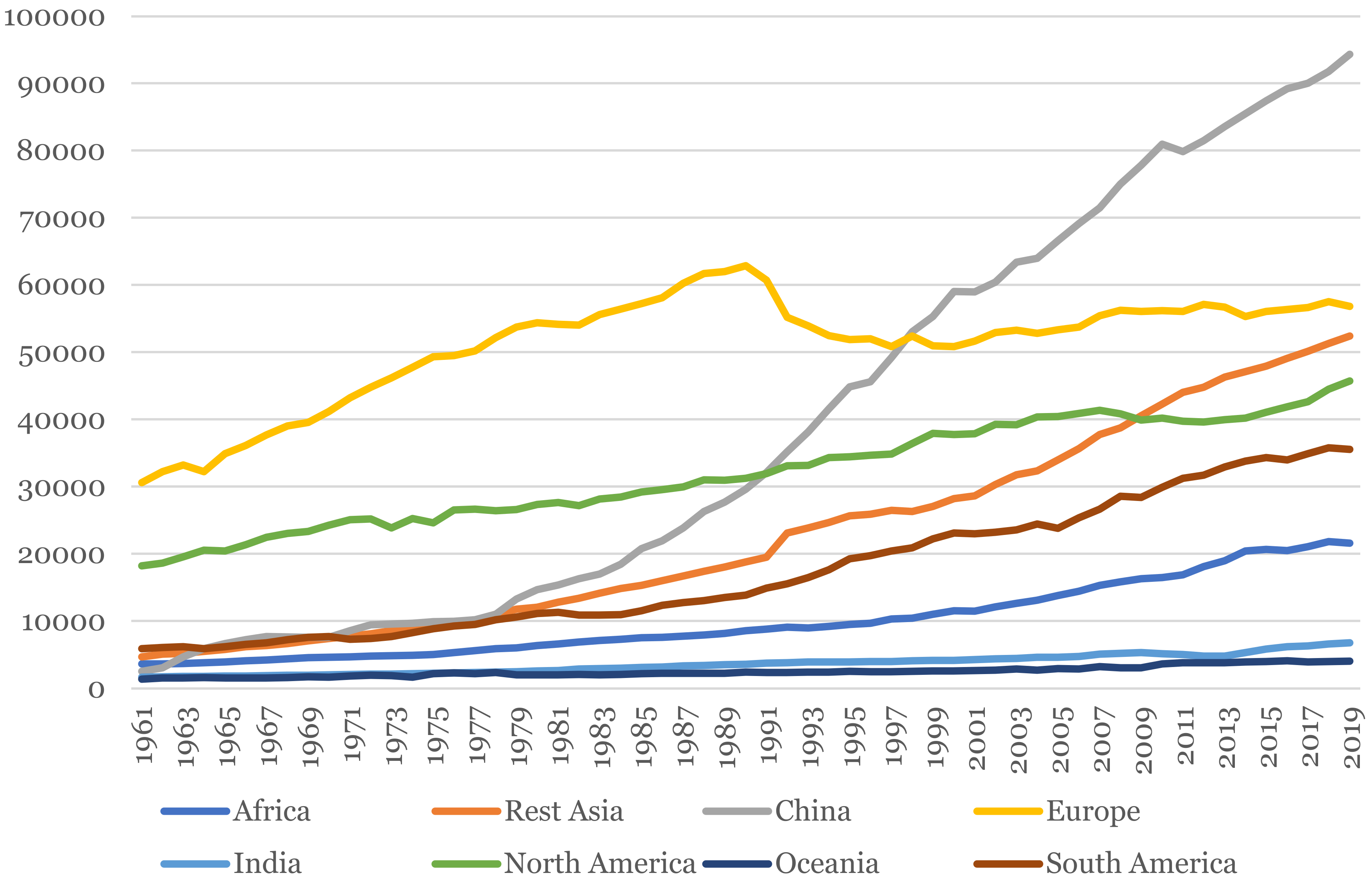

| Sample (2128) | Subsample (1040) | Portugal * | ∆ ** | |
|---|---|---|---|---|
| Gender | ||||
| Female | 75.05% (1597) | 52.88% (550) | 51.75% | 1.39 |
| Male | 24.72% (526) | 46.63% (485) | 48.25% | −1.61 |
| Non-binary | 0.23% (5) | 0.48% (5) | - | - |
| Age groups | ||||
| 15–19 | 8.22% (175) | 8.27% (86) | 8.24% | 0.03 |
| 20–24 | 20.44% (435) | 11.06% (115) | 8.32% | 2.74 |
| 25–29 | 13.06% (278) | 8.37% (87) | 8.27% | 0.10 |
| 30–34 | 9.45% (201) | 8.56% (89) | 8.56% | 0.00 |
| 35–39 | 9.30% (198) | 10.19% (106) | 10.16% | 0.03 |
| 40–44 | 10.57% (225) | 11.83% (123) | 11.85% | −0.02 |
| 45–49 | 10.15% (216) | 11.92% (124) | 11.93% | −0.01 |
| 50–54 | 7.89% (168) | 11.25% (117) | 11.26% | −0.01 |
| 55–59 | 7.28% (155) | 11.15% (116) | 11.18% | −0.03 |
| 60–64 | 3.62% (77) | 7.4% (77) | 10.23% | −2.83 |
| Regions | ||||
| Norte | 41.02% (873) | 35.87% (373) | 35.88% | −0.01 |
| Centro | 21.33% (454) | 21.25% (221) | 21.25% | 0.00 |
| Lisboa | 19.64% (418) | 26.83% (69) | 26.84% | 0.02 |
| Alentejo | 7.14% (152) | 6.63% (279) | 6.61% | 0.01 |
| Algarve | 4.61% (98) | 4.13% (43) | 4.18% | −0.05 |
| R.A. Açores | 2.63% (56) | 2.6% (27) | 2.56% | 0.04 |
| R.A. Madeira | 3.62% (77) | 2.69% (28) | 2.69% | 0.00 |
| Education | ||||
| Higher education | 70.21% (1494) | 59.23% (616) | 25.38% | 33.85 |
| Variable | Definition | Mean | Std. Dev. | Min. | Max. |
|---|---|---|---|---|---|
| MRED | Red meat meals per week | 2.202 | 0.715 | 1 (zero meals) | 4 (seven or more meals) |
| MWHT | White meat meals per week | 2.642 | 0.830 | 1 (zero meals) | 4 (seven or more meals) |
| FISH | Fish meals per week | 2.440 | 0.710 | 1 (zero meals) | 4 (seven or more meals) |
| OLVG | O-L-Vegetarian meals per week | 2.759 | 0.814 | 1 (zero meals) | 4 (seven or more meals) |
| VEGA | Vegan meals per week | 2.277 | 1.032 | 1 (zero meals) | 4 (seven or more meals) |
| Variable | Definition | Mean | Std. Dev. | Min. | Max. | |
|---|---|---|---|---|---|---|
| Group 1 | AGE | Age | 39.939 | 13.786 | 15 | 64 |
| FEM | 1 if female | 0.531 | 0.499 | 0 | 1 | |
| EDU | 1 if higher education | 0.592 | 0.492 | 0 | 1 | |
| SEA | 1 if seaside | 0.768 | 0.422 | 0 | 1 | |
| BMI | Body mass index | 24.961 | 4.532 | 13.84 | 44.19 | |
| SNG | 1 if single | 0.456 | 0.498 | 0 | 1 | |
| FAM | 1 if family | 0.861 | 0.347 | 0 | 1 | |
| K12 | 1 if kids under twelve | 0.252 | 0.434 | 0 | 1 | |
| STD | 1 if student | 0.242 | 0.429 | 0 | 1 | |
| HRS | Working hours | 31.904 | 16.546 | 0 | 90 | |
| INC | Disposable income | 2.630 | 1.243 | 1 | 7 | |
| LFT | 1 if left | 0.311 | 0.463 | 0 | 1 | |
| RGT | 1 if right | 0.170 | 0.376 | 0 | 1 | |
| CNS | 1 if conservative | 0.063 | 0.244 | 0 | 1 | |
| LIB | 1 if liberal | 0.302 | 0.459 | 0 | 1 | |
| CTL | 1 if catholic | 0.598 | 0.491 | 0 | 1 | |
| Group 2 | APE | Appearance | 3.566 | 1.075 | 1 | 5 |
| AWL | Animal Wellbeing | 3.453 | 1.089 | 1 | 5 | |
| PLE | Pleasure | 4.350 | 0.709 | 1 | 5 | |
| HLT | Health | 4.367 | 0.780 | 1 | 5 | |
| NVL | Novelty | 2.559 | 1.065 | 1 | 5 | |
| ORG | Origin | 3.362 | 1.175 | 1 | 5 | |
| NTR | Nutrition | 3.975 | 0.938 | 1 | 5 | |
| ENV | Environment | 3.701 | 1.021 | 1 | 5 | |
| PRC | Price | 4.044 | 0.831 | 1 | 5 | |
| FRT | Fairtrade | 3.907 | 0.889 | 1 | 5 | |
| CNV | Convenience | 3.802 | 0.870 | 1 | 5 | |
| NAT | Naturalness | 3.875 | 0.958 | 1 | 5 | |
| STQ | Status quo | 1.911 | 1.060 | 1 | 5 | |
| VRT | Variety | 4.041 | 0.849 | 1 | 5 | |
| INF | Information | 3.822 | 0.940 | 1 | 5 | |
| Group 3 | CHLD | Food for children | 3.164 | 1.415 | 1 | 5 |
| LWGT | Losing weight | 3.225 | 1.289 | 1 | 5 | |
| GWGT | Gaining weight | 2.178 | 1.325 | 1 | 5 | |
| TIME | Finding time | 3.638 | 1.068 | 1 | 5 | |
| AVOI | Avoid ingredients/nutrients | 3.749 | 1.056 | 1 | 5 | |
| LBLS | Read labels | 3.823 | 1.001 | 1 | 5 | |
| LOCA | Find local foods | 3.873 | 1.046 | 1 | 5 | |
| PRNC | Stand up for principles | 3.764 | 1.018 | 1 | 5 | |
| CONX | Consuming consciously | 3.987 | 0.939 | 1 | 5 | |
| Group 4 | INFO | 1 if looks for information | 0.706 | 0.456 | 0 | 1 |
| BIOL | 1 if favours biologic/organic | 0.678 | 0.468 | 0 | 1 | |
| COOK | 1 if cooks | 0.877 | 0.329 | 0 | 1 | |
| FAFH | Meals away-from-home | 2.143 | 2.202 | 0 | 10 | |
| FRTE | Meals ready-to-eat | 1.108 | 1.741 | 0 | 10 | |
| LFTO | 1 if uses leftovers | 0.550 | 0.498 | 0 | 1 | |
| SHOP | 1 if the one who buys food | 0.908 | 0.290 | 0 | 1 | |
| FEXP | Expenditure on food | 5.502 | 2.179 | 1 | 9 | |
| ROFP | 1 if owns food production | 0.406 | 0.491 | 0 | 1 | |
| CHNG | 1 if willing to change diet | 0.639 | 0.480 | 0 | 1 | |
| AWAR | Construct food awareness | 3.688 | 0.639 | 1.07 | 5 |
| True-Diet | ||||||
|---|---|---|---|---|---|---|
| Auto-Diet | Omnivorous | Pescatarian | Flexitarian | OLVeg. | Vegan | Total |
| Omnivorous | 844 | 0 | 0 | 0 | 0 | 844 |
| Pescatarian | 0 | 8 | 20 | 0 | 0 | 28 |
| Flexitarian | 0 | 17 | 72 | 0 | 0 | 89 |
| O-L-Vegetarian | 0 | 9 | 12 | 26 | 0 | 47 |
| Vegan | 0 | 1 | 7 | 6 | 18 | 32 |
| Total | 844 | 35 | 111 | 32 | 18 | 1040 |
Disclaimer/Publisher’s Note: The statements, opinions and data contained in all publications are solely those of the individual author(s) and contributor(s) and not of MDPI and/or the editor(s). MDPI and/or the editor(s) disclaim responsibility for any injury to people or property resulting from any ideas, methods, instructions or products referred to in the content. |
© 2023 by the authors. Licensee MDPI, Basel, Switzerland. This article is an open access article distributed under the terms and conditions of the Creative Commons Attribution (CC BY) license (https://creativecommons.org/licenses/by/4.0/).
Share and Cite
Pais, D.F.; Marques, A.C.; Fuinhas, J.A. How to Promote Healthier and More Sustainable Food Choices: The Case of Portugal. Sustainability 2023, 15, 3868. https://doi.org/10.3390/su15043868
Pais DF, Marques AC, Fuinhas JA. How to Promote Healthier and More Sustainable Food Choices: The Case of Portugal. Sustainability. 2023; 15(4):3868. https://doi.org/10.3390/su15043868
Chicago/Turabian StylePais, Daniel Francisco, António Cardoso Marques, and José Alberto Fuinhas. 2023. "How to Promote Healthier and More Sustainable Food Choices: The Case of Portugal" Sustainability 15, no. 4: 3868. https://doi.org/10.3390/su15043868
APA StylePais, D. F., Marques, A. C., & Fuinhas, J. A. (2023). How to Promote Healthier and More Sustainable Food Choices: The Case of Portugal. Sustainability, 15(4), 3868. https://doi.org/10.3390/su15043868







